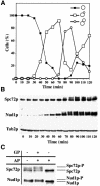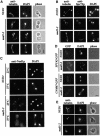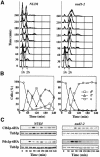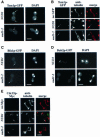Nud1p links astral microtubule organization and the control of exit from mitosis
- PMID: 11101520
- PMCID: PMC305870
- DOI: 10.1093/emboj/19.23.6475
Nud1p links astral microtubule organization and the control of exit from mitosis
Erratum in
- EMBO J 2001 Jan 15;20(1-2):305
Abstract
The budding yeast spindle pole body (SPB) not only organizes the astral and nuclear microtubules but is also associated with a number of cell-cycle regulators that control mitotic exit. Here, we describe that the core SPB component Nud1p is a key protein that functions in both processes. The astral microtubule organizing function of Nud1p is mediated by its interaction with the gamma-tubulin complex binding protein Spc72p. This function of Nud1p is distinct from its role in cell-cycle control: Nud1p binds the spindle checkpoint control proteins Bfa1p and Bub2p to the SPB, and is part of the mitotic exit network (MEN) in which it functions upstream of CDC15 but downstream of LTE1. In conditional lethal nud1-2 cells, the MEN component Tem1p, a GTPase, is mislocalized, whereas the kinase Cdc15p is still associated with the SPB. Thus, in nud1-2 cells the failure of Tem1p to interact with Cdc15p at the SPB probably prevents mitotic exit.
Figures










Similar articles
-
The Bub2p spindle checkpoint links nuclear migration with mitotic exit.Mol Cell. 2000 Jul;6(1):1-10. Mol Cell. 2000. PMID: 10949022
-
Modes of spindle pole body inheritance and segregation of the Bfa1p-Bub2p checkpoint protein complex.EMBO J. 2001 Nov 15;20(22):6359-70. doi: 10.1093/emboj/20.22.6359. EMBO J. 2001. PMID: 11707407 Free PMC article.
-
Regulation of the Bfa1p-Bub2p complex at spindle pole bodies by the cell cycle phosphatase Cdc14p.J Cell Biol. 2002 Apr 29;157(3):367-79. doi: 10.1083/jcb.200112085. Epub 2002 Apr 22. J Cell Biol. 2002. PMID: 11970961 Free PMC article.
-
Composition of the spindle pole body of Saccharomyces cerevisiae and the proteins involved in its duplication.Curr Genet. 2002 Feb;40(5):291-310. doi: 10.1007/s00294-001-0263-x. Epub 2001 Dec 8. Curr Genet. 2002. PMID: 11935220 Review.
-
Mitotic exit control: a space and time odyssey.Curr Biol. 2011 Oct 25;21(20):R857-9. doi: 10.1016/j.cub.2011.09.023. Curr Biol. 2011. PMID: 22032192 Review.
Cited by
-
A dynamical model of the spindle position checkpoint.Mol Syst Biol. 2012 May 8;8:582. doi: 10.1038/msb.2012.15. Mol Syst Biol. 2012. PMID: 22580890 Free PMC article.
-
Asymmetry of the budding yeast Tem1 GTPase at spindle poles is required for spindle positioning but not for mitotic exit.PLoS Genet. 2015 Feb 6;11(2):e1004938. doi: 10.1371/journal.pgen.1004938. eCollection 2015 Feb. PLoS Genet. 2015. PMID: 25658911 Free PMC article.
-
Spindle pole body-anchored Kar3 drives the nucleus along microtubules from another nucleus in preparation for nuclear fusion during yeast karyogamy.Genes Dev. 2013 Feb 1;27(3):335-49. doi: 10.1101/gad.206318.112. Genes Dev. 2013. PMID: 23388829 Free PMC article.
-
Prospore membrane formation linked to the leading edge protein (LEP) coat assembly.EMBO J. 2001 Dec 17;20(24):6946-57. doi: 10.1093/emboj/20.24.6946. EMBO J. 2001. PMID: 11742972 Free PMC article.
-
The spindle pole body protein Cdc11p links Sid4p to the fission yeast septation initiation network.Mol Biol Cell. 2002 Apr;13(4):1203-14. doi: 10.1091/mbc.01-09-0455. Mol Biol Cell. 2002. PMID: 11950932 Free PMC article.
References
Publication types
MeSH terms
Substances
LinkOut - more resources
Full Text Sources
Other Literature Sources
Molecular Biology Databases

